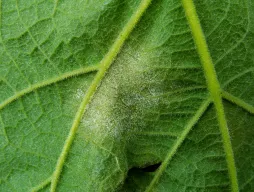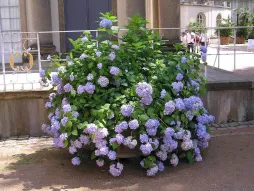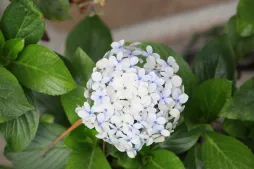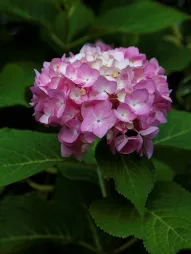Hydrangea macrophylla 'Mariesii lilacina ', a flat-headed hydrangea
In 1904, Victor Lemoine, a star nurseryman of the time, obtained a new hydrangea variety from hydrangea macrophylla (Hydrangea macrophylla). A century later, we continue to plant his Hydrangea macrophylla 'Mariesii lilacina' in our gardens and admire its bouquets of flat-headed purple flowers.
How to recognize Hydrangea 'Mariesii lilacina'?
An upright shrub with a rounded habit, Hydrangea 'Mariesii lilacina' reaches a height of two meters and a spread of 2.5 meters.
Hydrangea 'Mariseii lilacina' is a deciduous shrub. In winter, only the stem and branches with their grey or ochre bark remain. But for the rest of the year, the plant boasts oval, dark-green leaves. The largest are 20 centimetres long.
In summer, bunches of flat-headed flowers brighten up the plant. The inflorescence has two types of florets. In the center, small fertile flowers with barely visible petals and sepals form a compact ball. They are surrounded by decorative flowers with four colorful sepals. Their color ranges from blue to mauve to white. Several shades can be found in the same bouquet, with the darker hues generally on the outside of the inflorescence.
All parts of the plant are toxic to animals. If ingested, they cause digestive disorders. Absorbed in large quantities, the leaves and flowers can even cause nervous and cardiac problems. So avoid planting Hydrangea macrophylla 'Mariesii lilacina' in your home if you live with a curious dog or cat. You should also wear gloves when pruning or repotting your hydrangea. Its sap causes skin irritation in people with sensitive skin.
Our maintenance tips
The color of your Hydrangea 'Mariesii lilacina' depends largely on the pH of your soil. In acid soil, flowers are blue. In alkaline soil, flowers are pink or white.
Watering
Hydrangea macrophylla 'Mariesii lilacina' plants can withstand neither drought nor excess water.
Before watering, check the condition of the potting soil. The surface must be at least one centimeter dry.
Before watering, check the condition of the potting soil. The surface must be at least one centimeter dry.
Repotting
Obtain a perforated pot twice the size of the root ball. Fill it with a mixture of equal parts heather and garden soil.
Plant your Hydrangea 'Mariesii lilacina' in the center. Add potting soil, but do not fill the pot completely. Stop a few centimetres from the edge to form a watering basin. Press down and water generously.
Flowers are heavy and can bend branches. You can stake them to take the strain off the plant and keep it upright.
Fertilization
You can stimulate the growth of your plant during its growth phase, in spring and summer, with fertilizer.
Fertilize with a fertilizer for acid-loving plants. You can choose a hydrangea or bougainvillea fertilizer, for example.
Prune
Hydrangea macrophylla 'Mariesii lilacina' plants bloom on the previous year's wood. You mustn't prune too much, otherwise your plant won't flower.
Remove wilted flowers. Also remove frozen or broken branches.
Prune branches one to two centimetres above the last buds. Use a clean, sharp instrument to promote healing.
If your Hydrangea 'Mariesii lilacina' is old, cut back a few old branches by half to encourage new growth. But don't do it to all the branches! You won't have any flowers for a year!
Plantation
Once the last spring frosts have passed, you can plant.
Plant your Hydrangea 'Mariesii lilacina' in semi-shade, along a wall or under a tree to protect it from direct sun, frost and wind.
Soak the rootball of your Hydrangea 'Mariesii lilacina', still in its container. Preferably use rainwater. Tap water is often too hard.
Meanwhile, dig a hole 1.5 times deeper than the root ball and three times as big. Place a little compost at the bottom.
Plant your Hydrangea macrophylla ‘Mariesii lilacina’. The collar should reach ground level. Fill the hole with a mixture of heather soil (50%) and garden soil (50%).
Mulch the soilwith organic matter such as dead leaves or pine bark. Water copiously to encourage rooting.
You can also stake the flowers if their weight causes the stems to bend.
Cutting
Select a branch that has not yet flowered and whose tip is still flexible.
Take a section about ten centimetres long. Cut with clean, sharp pruning shears below a node.
Dress your cutting. Remove the leaves on the lower half of the shoot. You can reduce the size of the others by half.
Fill a pierced pot with a mixture of universal potting soil(1/3), sand(1/3) and heather (1/3). You can also use potting soil for seedlings and cuttings mixed with perlite. Form a pre-hole and plant your cutting in the center. Pack lightly.
Cutting is done in a smothered fashion. Place your Hydrangea 'Mariesii lilacina' in a mini greenhouse or translucent crate. You can also cover it with a transparent plastic bag.
Your cutting needs humidity to develop. Fog the leaves and potting soil whenthey are dry, to maintain a high level of humidity. But beware of rot! You need to aerate for a few minutes every day to avoid rot.
Diseases / Threats
Information
| Family | Hydrangeaceae - Hydrangeaceae |
| Type | Hydrangea - Hydrangea |
| Species | Large-leaf hydrangea - Hydrangea macrophylla |
| Lifecycle | Perennial |
| Foliage | Deciduous |
| Exposure | |
| Substrats | |
| Planting methods |
Open ground In pots In tubs |
| Categories | |
| Tags |
Beginner Flowery Rustic Toxic |
| Origin |
Southeast Asia |
| Hardiness (USDA) | 7a |
| Leaf color |
|
| Flower colors |
|
Discover plants from the same family





















